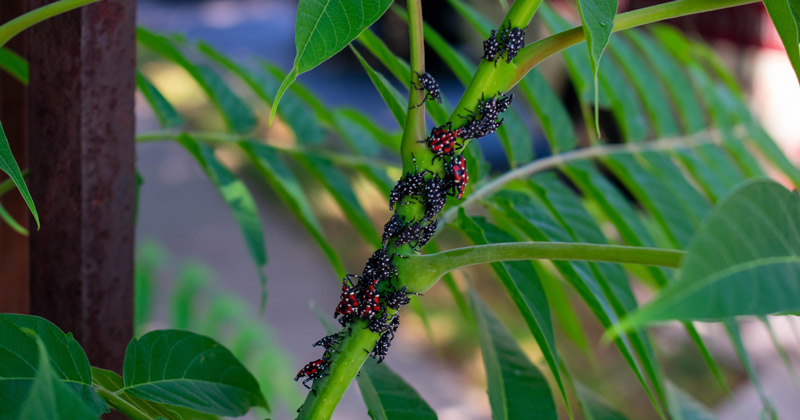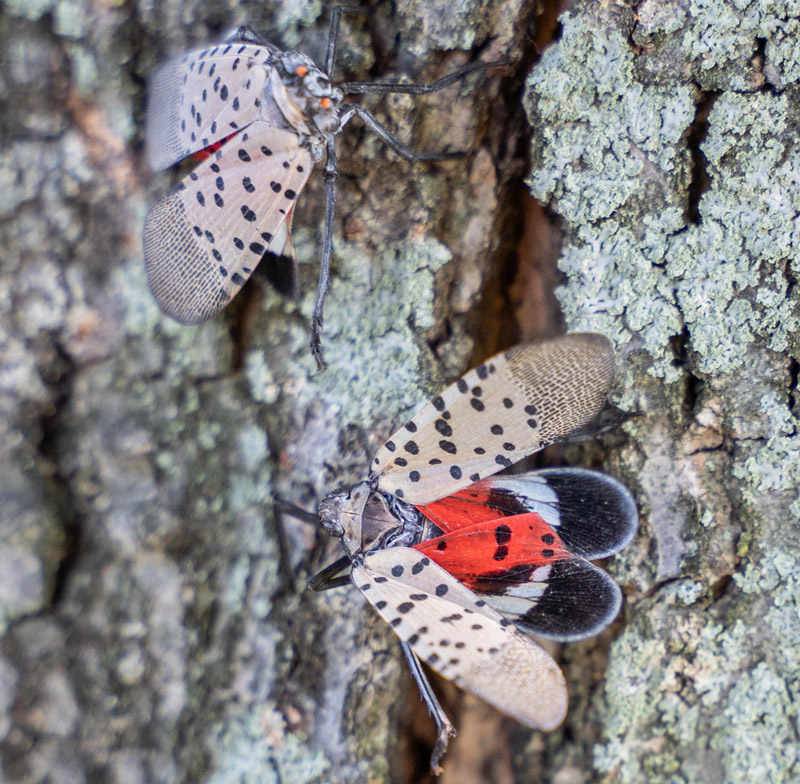


5 things to know about the spotted lanternfly
Photos by iStock August 18, 2020
UD’s resident expert offers tips on the region’s latest invasive pest
The spotted lanternfly must die.
It seems one of the few remaining facts on which we can all agree: These bugs are bad — bad for our backyards, our native ecosystem and our economy.
An invasive pest with a healthy appetite for plants like grapevines, hops and other fruit crops and trees, the spotted lanternfly feeds on a wide range of fruit, ornamental and woody trees, piercing the plant stems and tree bark, thus depleting the plant’s energy reserves and costing hundreds of millions of dollars annually in lost agriculture.
Now, as late summer approaches and as the insects mature and multiply, the University of Delaware's resident spotted lanternfly expert Brian Kunkel, extension specialist II in Cooperative Extension, offers five important things to know about these pests:
1. They can be hard to spot — and harder to kill.
Often mistaken for ticks (as babies) or moths (as adults), the spotted lanternfly is neither. Instead, it is known as a “hopper” and grows its wings only in the adult stage.
With eggs laid from September to mid-November, the insects hatch in early spring. Their coating is black, with white polka dots, and as they grow, they split along their back and crawl out into a new life stage.
In mid-summer, they turn red (still with white polka dots), and by August, most have morphed into their winged adult stage.
But “they’re fast little suckers,” as Kunkel puts it. With eyes on the sides of their heads, they are quick to evade a fatal stomp.
Killing them is no easy feat.
If using banding tape around trees, then Kunkel recommends using narrower bands or bands with a wire mesh over them to reduce the likelihood of “collateral capture” of other small mammals and birds. He also dissuades spraying any dish soap mixture on trees, as they can burn the leaves.
As an alternative, Kunkel suggests spraying Neem oil, which can help. But the most effective solution (so far) requires systemic insecticides.
2. There’s no easy “pest management” solution… yet.
Neonicotinoids, or “systemic” insecticides, are currently the most effective tool to kill the spotted lanternfly, said Kunkel. Such products — usually sprayed around the base of a tree — can last for months and kill thousands of nuisance insects, he added.
Unfortunately, more research is needed to determine their potential impact on pollinators.
“Caution should be used near flower-producing plants,” said Kunkel, explaining that researchers are still trying to understand the full impact of neonicotinoids. “We want to limit the root uptake of these insecticides in flowering plants because residues may get into flowers, and we need to minimize bee and pollinator exposure to neonicotinoids whenever possible.”
Responsible use of systemics is therefore critical, which is why Kunkel recommends applying insecticides after trees and nearby plants have flowered.
“You want to protect pollinators, but our most effective tool right now is a systemic that has potential impacts on them,” he said. “So how do you balance that? Awareness of this challenge is a valuable tool — but it makes things more complicated.”
3. Scientists are helping rear natural predators.
One possible non-pesticide solution is to find the insect’s natural enemies.
At the USDA Beneficial Insect Research Lab, located right on campus, researchers are rearing natural enemies for exotic invasive pests. They have found foes for the stinkbug and are currently working to combat the emerald ash borer.

The research team has also started projects focused on the spotted lanternfly, studying two natural enemies that help keep the lanternfly from being abundant in China, its native home.
After extensive evaluation, and if shown to be host-specific (meaning they will not attack other native North American insects), and if granted regulatory permission, the enemy insects could eventually be released to fight lanternfly.
“Any way we can manage it without using pesticides would be better,” said Kunkel.
4. Waste not, want not?
Spotted lanternfly excrement, otherwise known as honeydew, contains high concentrations of sugar. Such cheap, easy energy inevitably attracts other insects, such as yellowjackets, hornets and wasps.
“Yellowjackets are a gardener’s best friend because they pick out the caterpillars,” said Kunkel. “But if their hive is dangling from your deck, then that’s another problem.”
So beware: spotted lanternfly feeding attracts flies, ants and stinging insects that eat the sugars found in the honeydew.
5. Spotted lanternflies are excellent hitchhikers — but the problem isn’t going anywhere.
One possible sign of good news: the spotted lanternfly probably won’t kill your majestic trees, as “there have been no reported incidents of mature tree death,” said Kunkel.
But completely eradicating them will be unlikely, he added. “Although they prefer the tree of heaven, they can feed on many different things. They’re quick, mobile and excellent hitchhikers.”
They hide under the hood of the car, near windshield wipers, in the wheel wells of tires, nestled under bumpers — and they have been known to cling onto cars traveling at 50 miles per hour.
Fortunately for Delaware, they don’t typically feed off corn, soybean, watermelon, lima bean and other key crops for the state.
But because of UD's location along the I-95 corridor, they can easily find themselves in nearby states like Pennsylvania, Maryland and North Carolina, where native crops are at heightened risk.
“We want to be good neighbors,” said Kunkel. “And as bad as the problem currently is, we want to do what we can to slow the spread.”
Unfortunately, their populations are most likely going to get worse.
Insect populations often run along a wave, he explained, and we’re going up. “We haven’t even hit the crest yet. We’ll probably be managing this pest for quite some time.”
Contact Us
Have a UDaily story idea?
Contact us at ocm@udel.edu
Members of the press
Contact us at 302-831-NEWS or visit the Media Relations website

